Case Study: Mental Health Disorder and Risk of Suicide - NSB204
VerifiedAdded on 2023/06/05
|16
|3443
|157
Case Study
AI Summary
This case study analyzes a 27-year-old Aboriginal male presenting with suicidal ideation. It includes a detailed Mental Status Examination, clinical formulation identifying predisposing, precipitating, and perpetuating factors, and a comprehensive nursing care plan. The study emphasizes managing depression, addressing multiple risk factors, and promoting the client's self-control. The second part explores therapeutic engagement, focusing on building a therapeutic relationship, ensuring cultural safety, and implementing recovery-oriented nursing care. The study highlights the importance of professional conduct, cultural sensitivity, and individualized care to support the client's recovery and prevent self-harm. It also includes a clinical handover report and references relevant literature to support the analysis and recommendations.
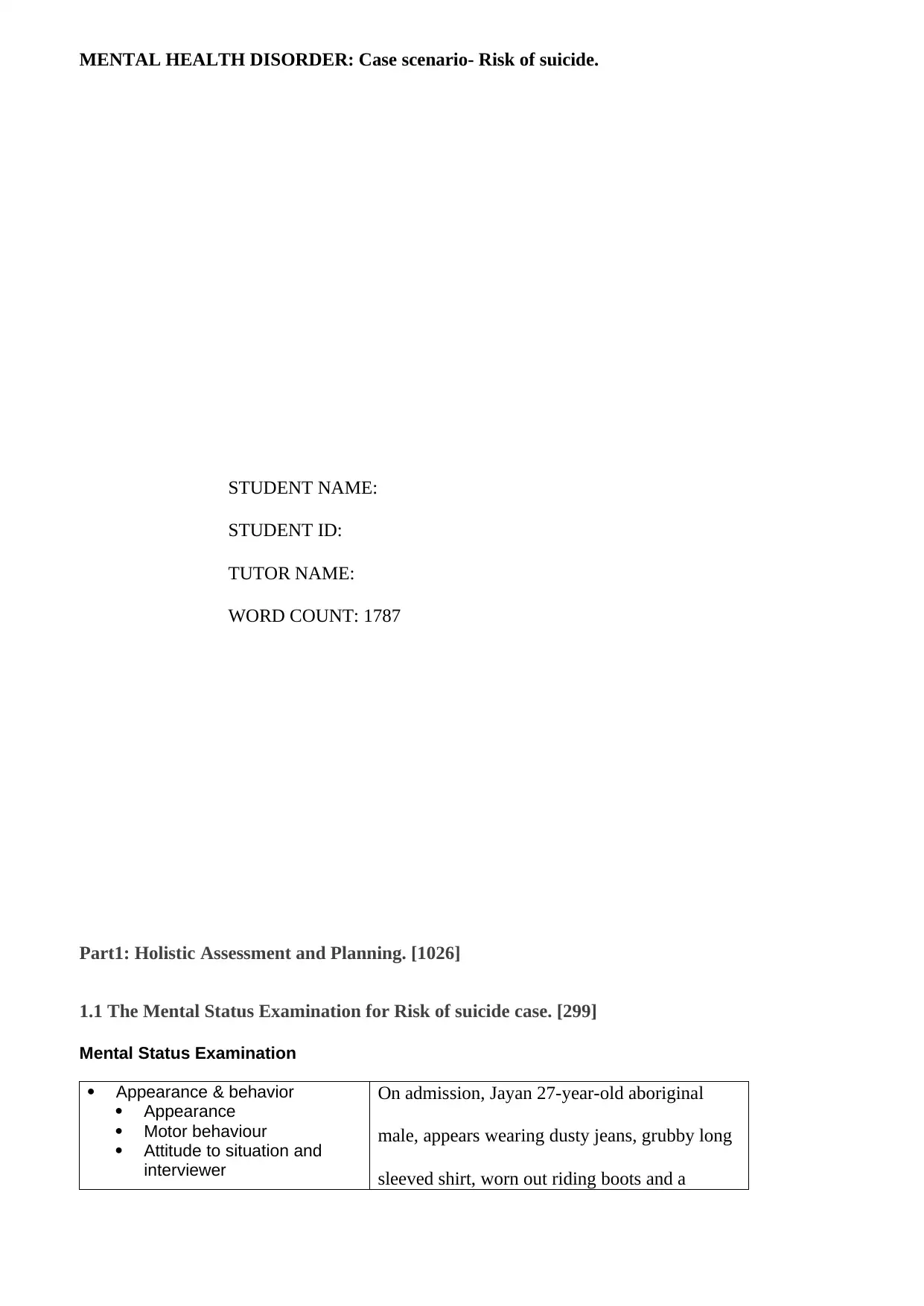
MENTAL HEALTH DISORDER: Case scenario- Risk of suicide.
STUDENT NAME:
STUDENT ID:
TUTOR NAME:
WORD COUNT: 1787
Part1: Holistic Assessment and Planning. [1026]
1.1 The Mental Status Examination for Risk of suicide case. [299]
Mental Status Examination
Appearance & behavior
Appearance
Motor behaviour
Attitude to situation and
interviewer
On admission, Jayan 27-year-old aboriginal
male, appears wearing dusty jeans, grubby long
sleeved shirt, worn out riding boots and a
STUDENT NAME:
STUDENT ID:
TUTOR NAME:
WORD COUNT: 1787
Part1: Holistic Assessment and Planning. [1026]
1.1 The Mental Status Examination for Risk of suicide case. [299]
Mental Status Examination
Appearance & behavior
Appearance
Motor behaviour
Attitude to situation and
interviewer
On admission, Jayan 27-year-old aboriginal
male, appears wearing dusty jeans, grubby long
sleeved shirt, worn out riding boots and a
Paraphrase This Document
Need a fresh take? Get an instant paraphrase of this document with our AI Paraphraser

cowboy hat.
He is thin and appears much younger than stated
age with long shaggy dark hair. Has tattooed
fingers.
Quiet and tearful.
Restrictive to answer at first during interview.
Cooperative and open.
Speech Form
Rate
Volume
Quantity of information
Speech Content
Disturbance of meaning
Disturbance of language
Slow (he speaks quietly).
Soft. (Quietly speaks).
Monosyllabic and expansive.
No disturbance of meaning or language.
Mood and Affect
Mood
Affect
Congruency
Depressed, sad and hopeless (Indicators of
suicidal thinking) tearful, anxious.
Affect: Flat
Appropriate congruency.
Form of Thought
Amount of thought
Continuity of ideas
Disturbance of language or
meaning
Linear flow of ideas.
No disturbance of language or meaning.
Content of Thought
Delusions
Suicidal thoughts
Other
Paranoia-Jealous about who his girlfriend.
(relationship).
Hopeless.
Suicidal ideation- intent to harm self.
Preoccupations, fear and obsession.
Perception
Hallucinations
Illusions
Depersonalisation
Derealisation
No hallucination
No illusions.
Decreased care to self.
Sensorium and Cognition Conscious (concentrates with ability to focus
He is thin and appears much younger than stated
age with long shaggy dark hair. Has tattooed
fingers.
Quiet and tearful.
Restrictive to answer at first during interview.
Cooperative and open.
Speech Form
Rate
Volume
Quantity of information
Speech Content
Disturbance of meaning
Disturbance of language
Slow (he speaks quietly).
Soft. (Quietly speaks).
Monosyllabic and expansive.
No disturbance of meaning or language.
Mood and Affect
Mood
Affect
Congruency
Depressed, sad and hopeless (Indicators of
suicidal thinking) tearful, anxious.
Affect: Flat
Appropriate congruency.
Form of Thought
Amount of thought
Continuity of ideas
Disturbance of language or
meaning
Linear flow of ideas.
No disturbance of language or meaning.
Content of Thought
Delusions
Suicidal thoughts
Other
Paranoia-Jealous about who his girlfriend.
(relationship).
Hopeless.
Suicidal ideation- intent to harm self.
Preoccupations, fear and obsession.
Perception
Hallucinations
Illusions
Depersonalisation
Derealisation
No hallucination
No illusions.
Decreased care to self.
Sensorium and Cognition Conscious (concentrates with ability to focus

Level of Consciousness
Memory
Orientation
Abstract thinking
and shift attention.)
Memory not assessed but Recalls past events.
Attentive throughout the interview
Insight & Judgment
Extent of individual’s
awareness of the problem
Can they make rational
decisions?
Has low insight towards his mental health state.
Impaired judgment as his ability to make
positive decision is compromised. He engages
in risky behaviors such as excessive drinking.
Risk Assessment Plan to harm self (as evident by suicidal
ideation.).
No harm to others
Family history of harm to self.
Vulnerable to access to high means of harm self
(ropes and bush).
Table1: The Mental Status Examination for Risk of suicide case.
1.2 Clinical Formulation Table. [198]
Presenting
factors
Anxious and worried.
Dramatic changes in moods (moody).
Member of minority group(Aboriginal)
Hopelessness-The client is hopeless about present and future.
Love-The client is seemingly in love as evident by the tattoos engraved
with the word ‘LOVE’
(Bolton,2015)
(Turecki, & Brent,2016)
Precipitating Illness- concurrent mental health disorder (depression).
Memory
Orientation
Abstract thinking
and shift attention.)
Memory not assessed but Recalls past events.
Attentive throughout the interview
Insight & Judgment
Extent of individual’s
awareness of the problem
Can they make rational
decisions?
Has low insight towards his mental health state.
Impaired judgment as his ability to make
positive decision is compromised. He engages
in risky behaviors such as excessive drinking.
Risk Assessment Plan to harm self (as evident by suicidal
ideation.).
No harm to others
Family history of harm to self.
Vulnerable to access to high means of harm self
(ropes and bush).
Table1: The Mental Status Examination for Risk of suicide case.
1.2 Clinical Formulation Table. [198]
Presenting
factors
Anxious and worried.
Dramatic changes in moods (moody).
Member of minority group(Aboriginal)
Hopelessness-The client is hopeless about present and future.
Love-The client is seemingly in love as evident by the tattoos engraved
with the word ‘LOVE’
(Bolton,2015)
(Turecki, & Brent,2016)
Precipitating Illness- concurrent mental health disorder (depression).
⊘ This is a preview!⊘
Do you want full access?
Subscribe today to unlock all pages.

Trusted by 1+ million students worldwide
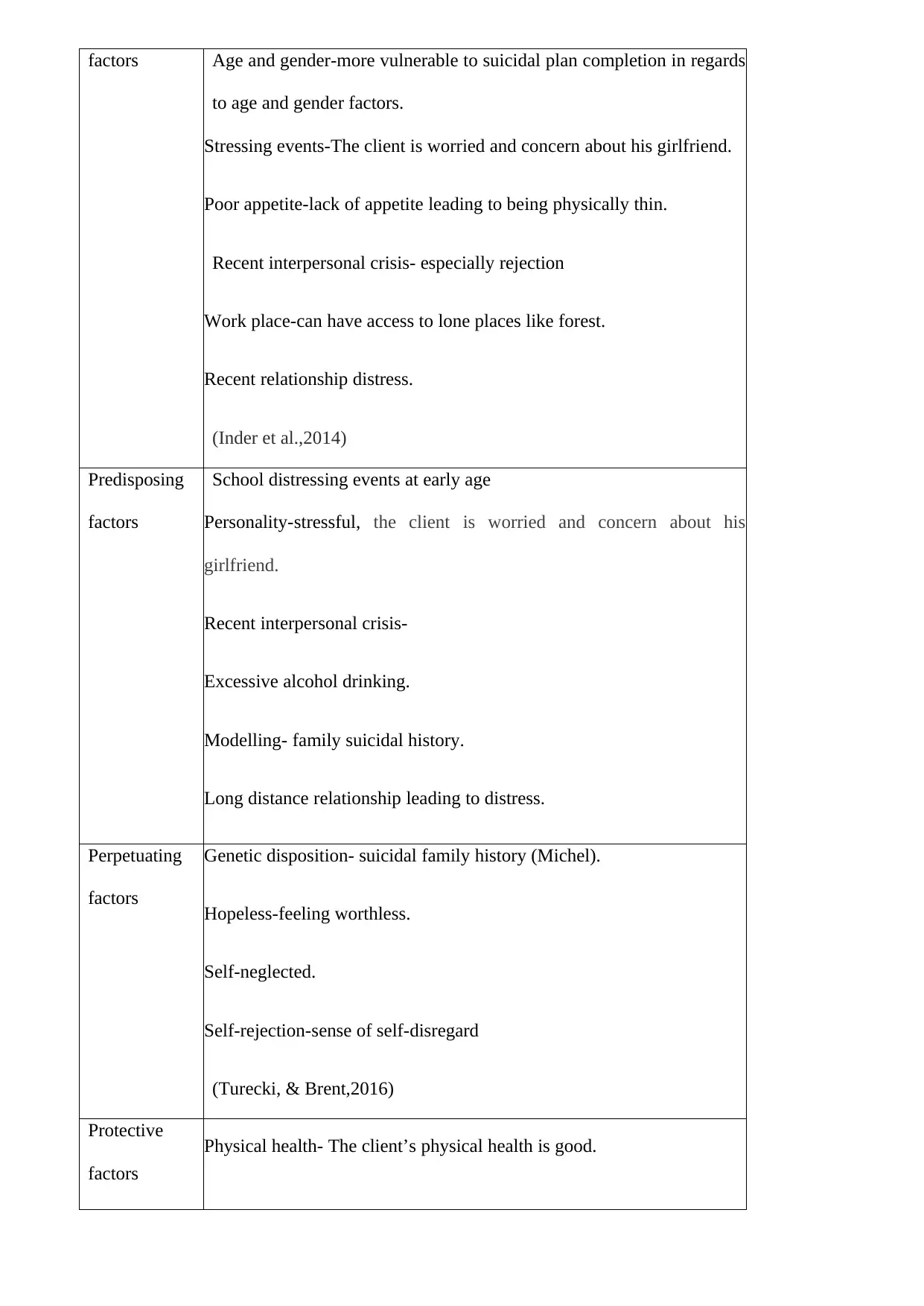
factors Age and gender-more vulnerable to suicidal plan completion in regards
to age and gender factors.
Stressing events-The client is worried and concern about his girlfriend.
Poor appetite-lack of appetite leading to being physically thin.
Recent interpersonal crisis- especially rejection
Work place-can have access to lone places like forest.
Recent relationship distress.
(Inder et al.,2014)
Predisposing
factors
School distressing events at early age
Personality-stressful, the client is worried and concern about his
girlfriend.
Recent interpersonal crisis-
Excessive alcohol drinking.
Modelling- family suicidal history.
Long distance relationship leading to distress.
Perpetuating
factors
Genetic disposition- suicidal family history (Michel).
Hopeless-feeling worthless.
Self-neglected.
Self-rejection-sense of self-disregard
(Turecki, & Brent,2016)
Protective
factors
Physical health- The client’s physical health is good.
to age and gender factors.
Stressing events-The client is worried and concern about his girlfriend.
Poor appetite-lack of appetite leading to being physically thin.
Recent interpersonal crisis- especially rejection
Work place-can have access to lone places like forest.
Recent relationship distress.
(Inder et al.,2014)
Predisposing
factors
School distressing events at early age
Personality-stressful, the client is worried and concern about his
girlfriend.
Recent interpersonal crisis-
Excessive alcohol drinking.
Modelling- family suicidal history.
Long distance relationship leading to distress.
Perpetuating
factors
Genetic disposition- suicidal family history (Michel).
Hopeless-feeling worthless.
Self-neglected.
Self-rejection-sense of self-disregard
(Turecki, & Brent,2016)
Protective
factors
Physical health- The client’s physical health is good.
Paraphrase This Document
Need a fresh take? Get an instant paraphrase of this document with our AI Paraphraser
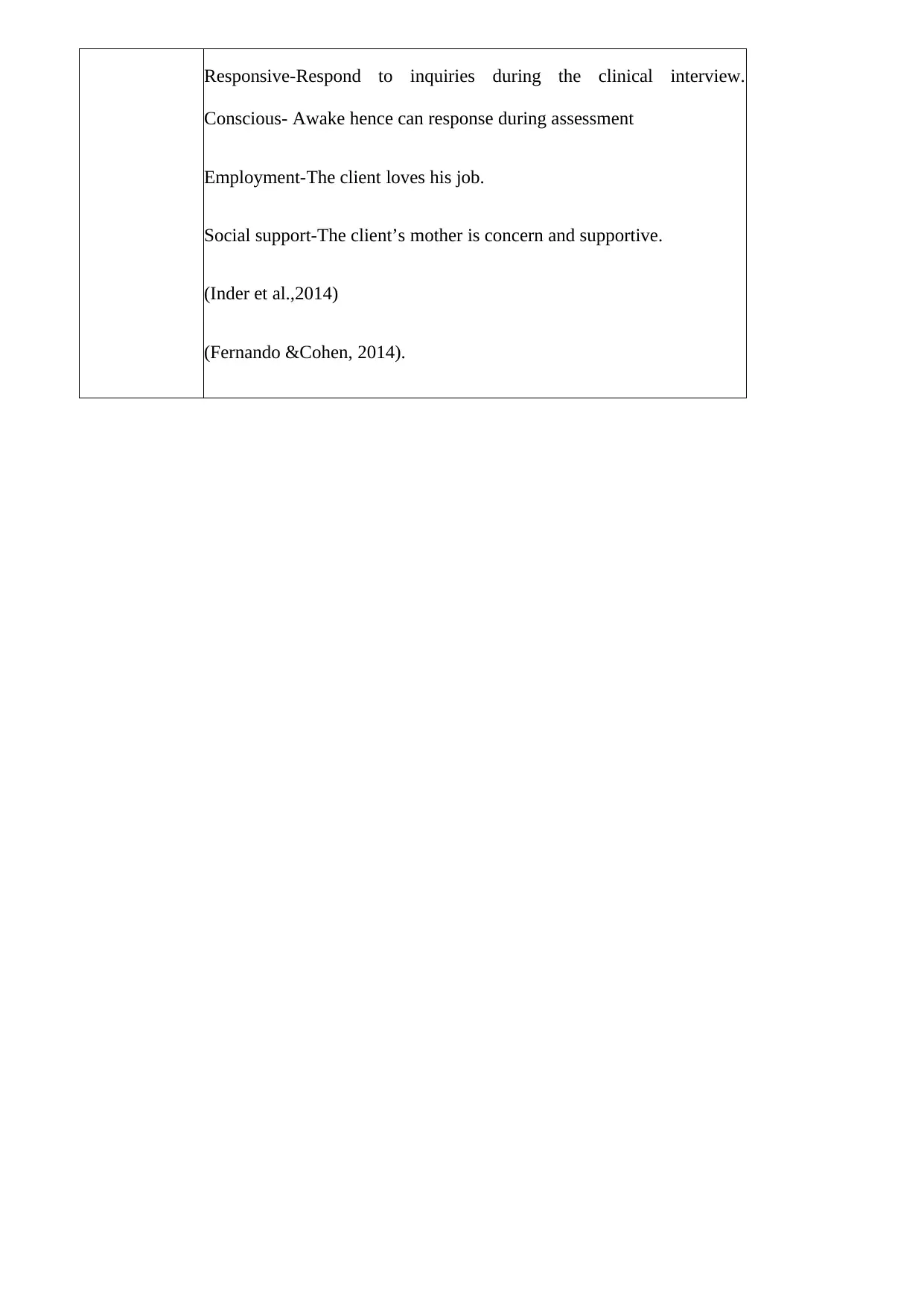
Responsive-Respond to inquiries during the clinical interview.
Conscious- Awake hence can response during assessment
Employment-The client loves his job.
Social support-The client’s mother is concern and supportive.
(Inder et al.,2014)
(Fernando &Cohen, 2014).
Conscious- Awake hence can response during assessment
Employment-The client loves his job.
Social support-The client’s mother is concern and supportive.
(Inder et al.,2014)
(Fernando &Cohen, 2014).
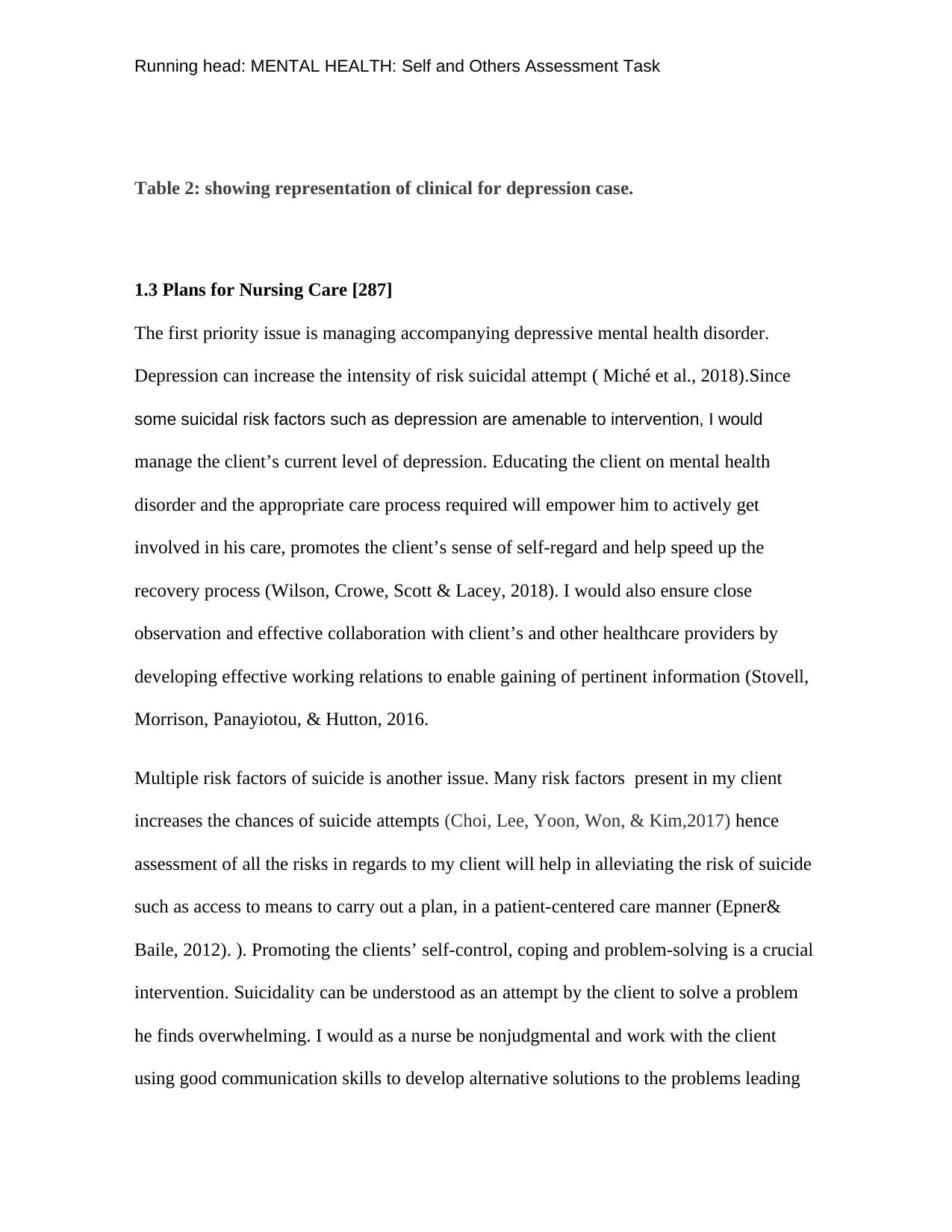
Running head: MENTAL HEALTH: Self and Others Assessment Task
Table 2: showing representation of clinical for depression case.
1.3 Plans for Nursing Care [287]
The first priority issue is managing accompanying depressive mental health disorder.
Depression can increase the intensity of risk suicidal attempt ( Miché et al., 2018).Since
some suicidal risk factors such as depression are amenable to intervention, I would
manage the client’s current level of depression. Educating the client on mental health
disorder and the appropriate care process required will empower him to actively get
involved in his care, promotes the client’s sense of self-regard and help speed up the
recovery process (Wilson, Crowe, Scott & Lacey, 2018). I would also ensure close
observation and effective collaboration with client’s and other healthcare providers by
developing effective working relations to enable gaining of pertinent information (Stovell,
Morrison, Panayiotou, & Hutton, 2016.
Multiple risk factors of suicide is another issue. Many risk factors present in my client
increases the chances of suicide attempts (Choi, Lee, Yoon, Won, & Kim,2017) hence
assessment of all the risks in regards to my client will help in alleviating the risk of suicide
such as access to means to carry out a plan, in a patient-centered care manner (Epner&
Baile, 2012). ). Promoting the clients’ self-control, coping and problem-solving is a crucial
intervention. Suicidality can be understood as an attempt by the client to solve a problem
he finds overwhelming. I would as a nurse be nonjudgmental and work with the client
using good communication skills to develop alternative solutions to the problems leading
Table 2: showing representation of clinical for depression case.
1.3 Plans for Nursing Care [287]
The first priority issue is managing accompanying depressive mental health disorder.
Depression can increase the intensity of risk suicidal attempt ( Miché et al., 2018).Since
some suicidal risk factors such as depression are amenable to intervention, I would
manage the client’s current level of depression. Educating the client on mental health
disorder and the appropriate care process required will empower him to actively get
involved in his care, promotes the client’s sense of self-regard and help speed up the
recovery process (Wilson, Crowe, Scott & Lacey, 2018). I would also ensure close
observation and effective collaboration with client’s and other healthcare providers by
developing effective working relations to enable gaining of pertinent information (Stovell,
Morrison, Panayiotou, & Hutton, 2016.
Multiple risk factors of suicide is another issue. Many risk factors present in my client
increases the chances of suicide attempts (Choi, Lee, Yoon, Won, & Kim,2017) hence
assessment of all the risks in regards to my client will help in alleviating the risk of suicide
such as access to means to carry out a plan, in a patient-centered care manner (Epner&
Baile, 2012). ). Promoting the clients’ self-control, coping and problem-solving is a crucial
intervention. Suicidality can be understood as an attempt by the client to solve a problem
he finds overwhelming. I would as a nurse be nonjudgmental and work with the client
using good communication skills to develop alternative solutions to the problems leading
⊘ This is a preview!⊘
Do you want full access?
Subscribe today to unlock all pages.

Trusted by 1+ million students worldwide
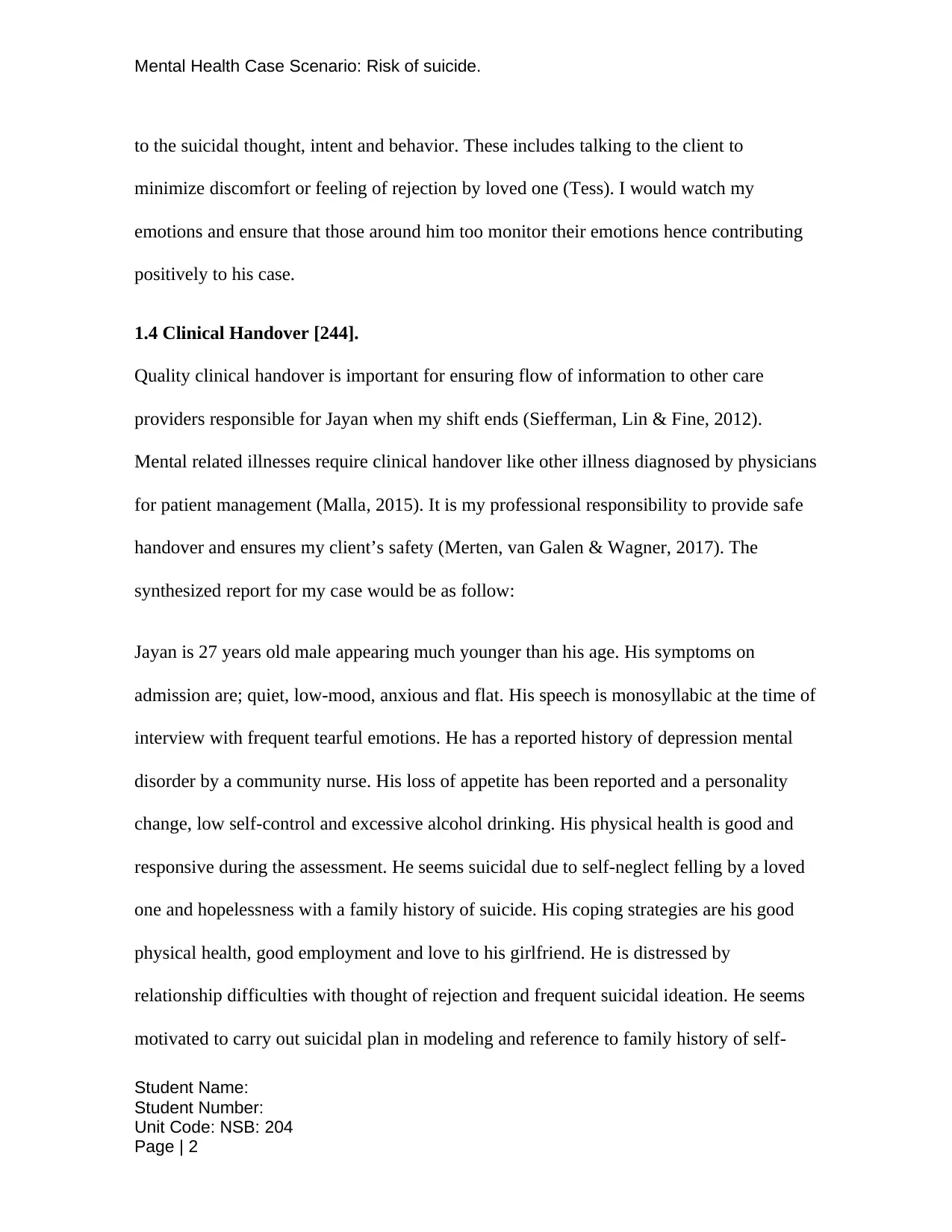
Mental Health Case Scenario: Risk of suicide.
to the suicidal thought, intent and behavior. These includes talking to the client to
minimize discomfort or feeling of rejection by loved one (Tess). I would watch my
emotions and ensure that those around him too monitor their emotions hence contributing
positively to his case.
1.4 Clinical Handover [244].
Quality clinical handover is important for ensuring flow of information to other care
providers responsible for Jayan when my shift ends (Siefferman, Lin & Fine, 2012).
Mental related illnesses require clinical handover like other illness diagnosed by physicians
for patient management (Malla, 2015). It is my professional responsibility to provide safe
handover and ensures my client’s safety (Merten, van Galen & Wagner, 2017). The
synthesized report for my case would be as follow:
Jayan is 27 years old male appearing much younger than his age. His symptoms on
admission are; quiet, low-mood, anxious and flat. His speech is monosyllabic at the time of
interview with frequent tearful emotions. He has a reported history of depression mental
disorder by a community nurse. His loss of appetite has been reported and a personality
change, low self-control and excessive alcohol drinking. His physical health is good and
responsive during the assessment. He seems suicidal due to self-neglect felling by a loved
one and hopelessness with a family history of suicide. His coping strategies are his good
physical health, good employment and love to his girlfriend. He is distressed by
relationship difficulties with thought of rejection and frequent suicidal ideation. He seems
motivated to carry out suicidal plan in modeling and reference to family history of self-
Student Name:
Student Number:
Unit Code: NSB: 204
Page | 2
to the suicidal thought, intent and behavior. These includes talking to the client to
minimize discomfort or feeling of rejection by loved one (Tess). I would watch my
emotions and ensure that those around him too monitor their emotions hence contributing
positively to his case.
1.4 Clinical Handover [244].
Quality clinical handover is important for ensuring flow of information to other care
providers responsible for Jayan when my shift ends (Siefferman, Lin & Fine, 2012).
Mental related illnesses require clinical handover like other illness diagnosed by physicians
for patient management (Malla, 2015). It is my professional responsibility to provide safe
handover and ensures my client’s safety (Merten, van Galen & Wagner, 2017). The
synthesized report for my case would be as follow:
Jayan is 27 years old male appearing much younger than his age. His symptoms on
admission are; quiet, low-mood, anxious and flat. His speech is monosyllabic at the time of
interview with frequent tearful emotions. He has a reported history of depression mental
disorder by a community nurse. His loss of appetite has been reported and a personality
change, low self-control and excessive alcohol drinking. His physical health is good and
responsive during the assessment. He seems suicidal due to self-neglect felling by a loved
one and hopelessness with a family history of suicide. His coping strategies are his good
physical health, good employment and love to his girlfriend. He is distressed by
relationship difficulties with thought of rejection and frequent suicidal ideation. He seems
motivated to carry out suicidal plan in modeling and reference to family history of self-
Student Name:
Student Number:
Unit Code: NSB: 204
Page | 2
Paraphrase This Document
Need a fresh take? Get an instant paraphrase of this document with our AI Paraphraser
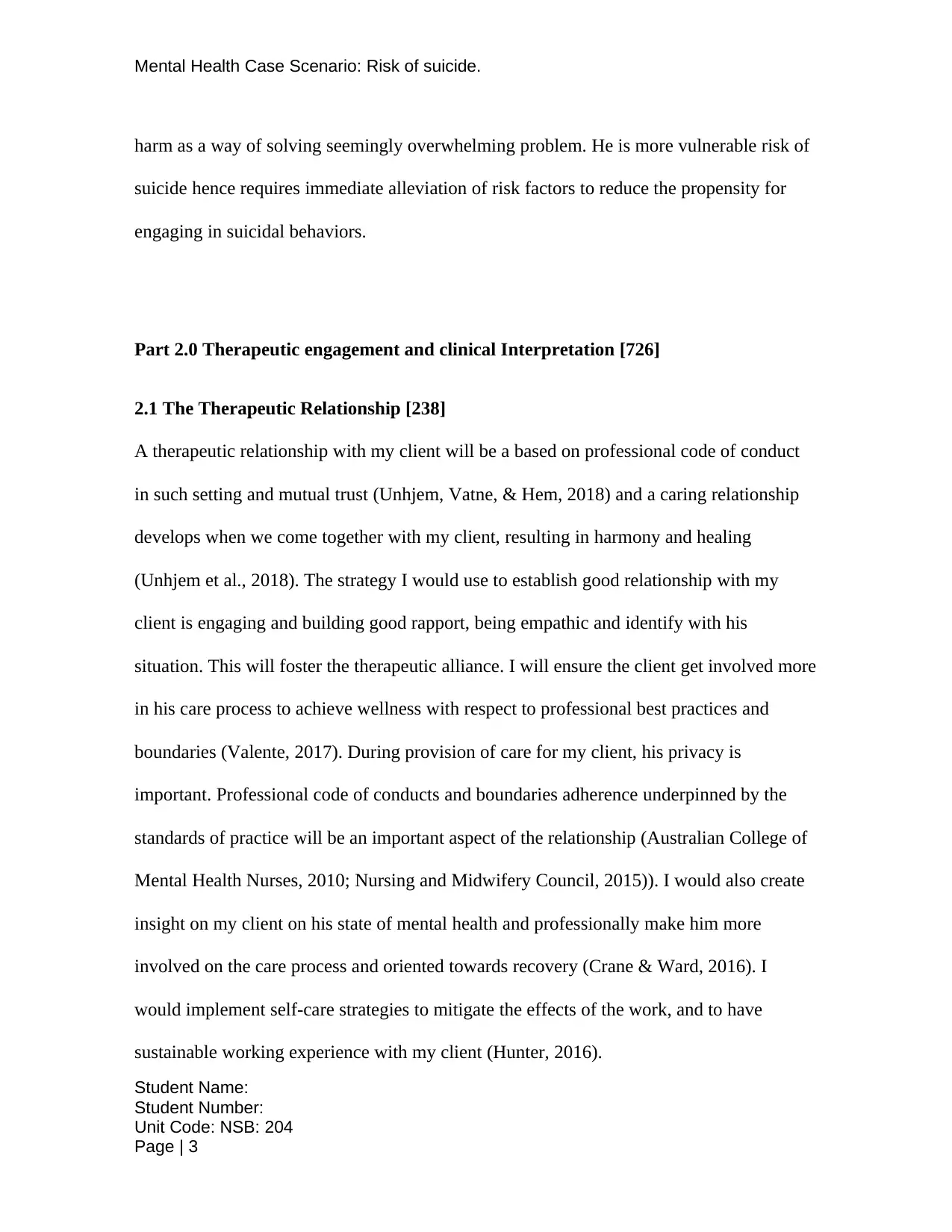
Mental Health Case Scenario: Risk of suicide.
harm as a way of solving seemingly overwhelming problem. He is more vulnerable risk of
suicide hence requires immediate alleviation of risk factors to reduce the propensity for
engaging in suicidal behaviors.
Part 2.0 Therapeutic engagement and clinical Interpretation [726]
2.1 The Therapeutic Relationship [238]
A therapeutic relationship with my client will be a based on professional code of conduct
in such setting and mutual trust (Unhjem, Vatne, & Hem, 2018) and a caring relationship
develops when we come together with my client, resulting in harmony and healing
(Unhjem et al., 2018). The strategy I would use to establish good relationship with my
client is engaging and building good rapport, being empathic and identify with his
situation. This will foster the therapeutic alliance. I will ensure the client get involved more
in his care process to achieve wellness with respect to professional best practices and
boundaries (Valente, 2017). During provision of care for my client, his privacy is
important. Professional code of conducts and boundaries adherence underpinned by the
standards of practice will be an important aspect of the relationship (Australian College of
Mental Health Nurses, 2010; Nursing and Midwifery Council, 2015)). I would also create
insight on my client on his state of mental health and professionally make him more
involved on the care process and oriented towards recovery (Crane & Ward, 2016). I
would implement self-care strategies to mitigate the effects of the work, and to have
sustainable working experience with my client (Hunter, 2016).
Student Name:
Student Number:
Unit Code: NSB: 204
Page | 3
harm as a way of solving seemingly overwhelming problem. He is more vulnerable risk of
suicide hence requires immediate alleviation of risk factors to reduce the propensity for
engaging in suicidal behaviors.
Part 2.0 Therapeutic engagement and clinical Interpretation [726]
2.1 The Therapeutic Relationship [238]
A therapeutic relationship with my client will be a based on professional code of conduct
in such setting and mutual trust (Unhjem, Vatne, & Hem, 2018) and a caring relationship
develops when we come together with my client, resulting in harmony and healing
(Unhjem et al., 2018). The strategy I would use to establish good relationship with my
client is engaging and building good rapport, being empathic and identify with his
situation. This will foster the therapeutic alliance. I will ensure the client get involved more
in his care process to achieve wellness with respect to professional best practices and
boundaries (Valente, 2017). During provision of care for my client, his privacy is
important. Professional code of conducts and boundaries adherence underpinned by the
standards of practice will be an important aspect of the relationship (Australian College of
Mental Health Nurses, 2010; Nursing and Midwifery Council, 2015)). I would also create
insight on my client on his state of mental health and professionally make him more
involved on the care process and oriented towards recovery (Crane & Ward, 2016). I
would implement self-care strategies to mitigate the effects of the work, and to have
sustainable working experience with my client (Hunter, 2016).
Student Name:
Student Number:
Unit Code: NSB: 204
Page | 3
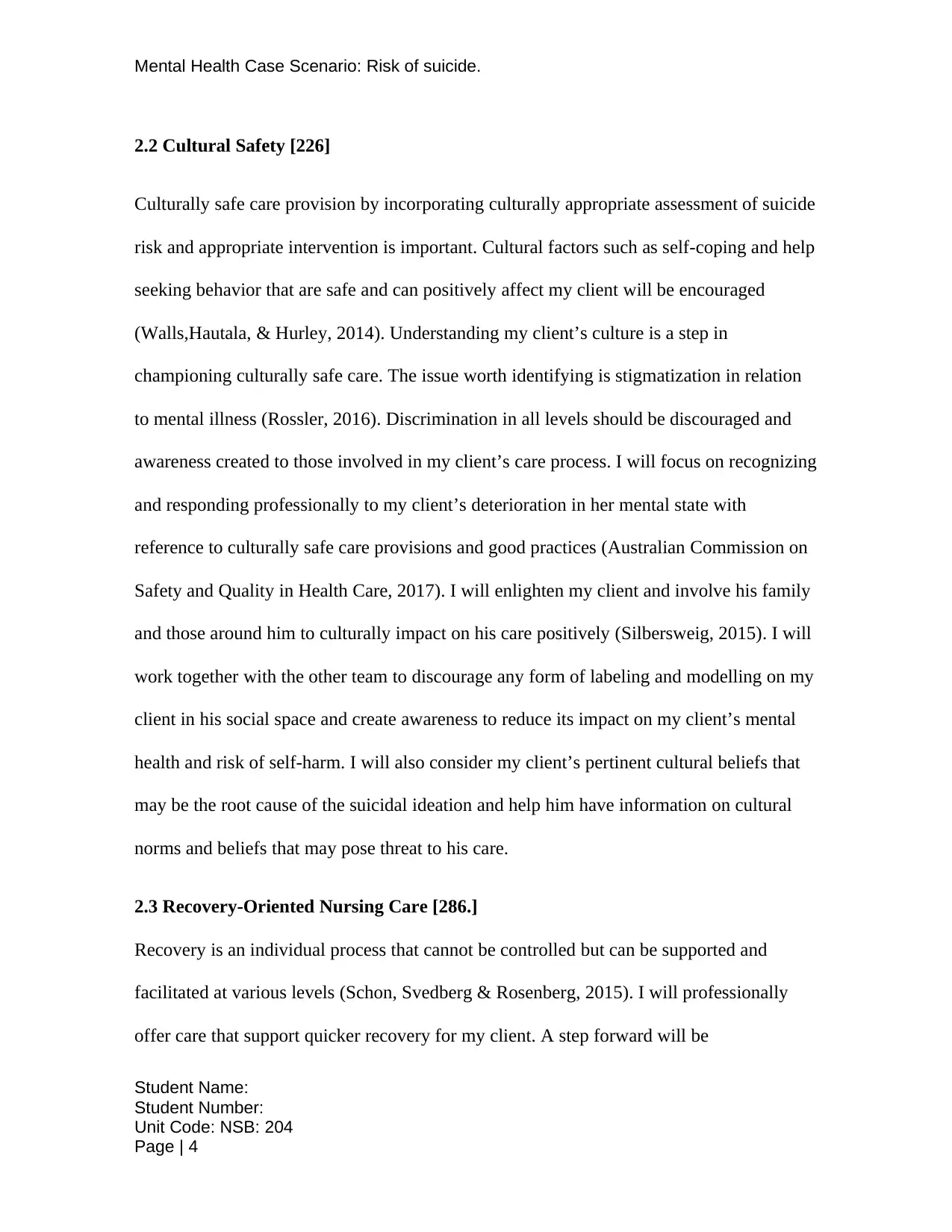
Mental Health Case Scenario: Risk of suicide.
2.2 Cultural Safety [226]
Culturally safe care provision by incorporating culturally appropriate assessment of suicide
risk and appropriate intervention is important. Cultural factors such as self-coping and help
seeking behavior that are safe and can positively affect my client will be encouraged
(Walls,Hautala, & Hurley, 2014). Understanding my client’s culture is a step in
championing culturally safe care. The issue worth identifying is stigmatization in relation
to mental illness (Rossler, 2016). Discrimination in all levels should be discouraged and
awareness created to those involved in my client’s care process. I will focus on recognizing
and responding professionally to my client’s deterioration in her mental state with
reference to culturally safe care provisions and good practices (Australian Commission on
Safety and Quality in Health Care, 2017). I will enlighten my client and involve his family
and those around him to culturally impact on his care positively (Silbersweig, 2015). I will
work together with the other team to discourage any form of labeling and modelling on my
client in his social space and create awareness to reduce its impact on my client’s mental
health and risk of self-harm. I will also consider my client’s pertinent cultural beliefs that
may be the root cause of the suicidal ideation and help him have information on cultural
norms and beliefs that may pose threat to his care.
2.3 Recovery-Oriented Nursing Care [286.]
Recovery is an individual process that cannot be controlled but can be supported and
facilitated at various levels (Schon, Svedberg & Rosenberg, 2015). I will professionally
offer care that support quicker recovery for my client. A step forward will be
Student Name:
Student Number:
Unit Code: NSB: 204
Page | 4
2.2 Cultural Safety [226]
Culturally safe care provision by incorporating culturally appropriate assessment of suicide
risk and appropriate intervention is important. Cultural factors such as self-coping and help
seeking behavior that are safe and can positively affect my client will be encouraged
(Walls,Hautala, & Hurley, 2014). Understanding my client’s culture is a step in
championing culturally safe care. The issue worth identifying is stigmatization in relation
to mental illness (Rossler, 2016). Discrimination in all levels should be discouraged and
awareness created to those involved in my client’s care process. I will focus on recognizing
and responding professionally to my client’s deterioration in her mental state with
reference to culturally safe care provisions and good practices (Australian Commission on
Safety and Quality in Health Care, 2017). I will enlighten my client and involve his family
and those around him to culturally impact on his care positively (Silbersweig, 2015). I will
work together with the other team to discourage any form of labeling and modelling on my
client in his social space and create awareness to reduce its impact on my client’s mental
health and risk of self-harm. I will also consider my client’s pertinent cultural beliefs that
may be the root cause of the suicidal ideation and help him have information on cultural
norms and beliefs that may pose threat to his care.
2.3 Recovery-Oriented Nursing Care [286.]
Recovery is an individual process that cannot be controlled but can be supported and
facilitated at various levels (Schon, Svedberg & Rosenberg, 2015). I will professionally
offer care that support quicker recovery for my client. A step forward will be
Student Name:
Student Number:
Unit Code: NSB: 204
Page | 4
⊘ This is a preview!⊘
Do you want full access?
Subscribe today to unlock all pages.

Trusted by 1+ million students worldwide
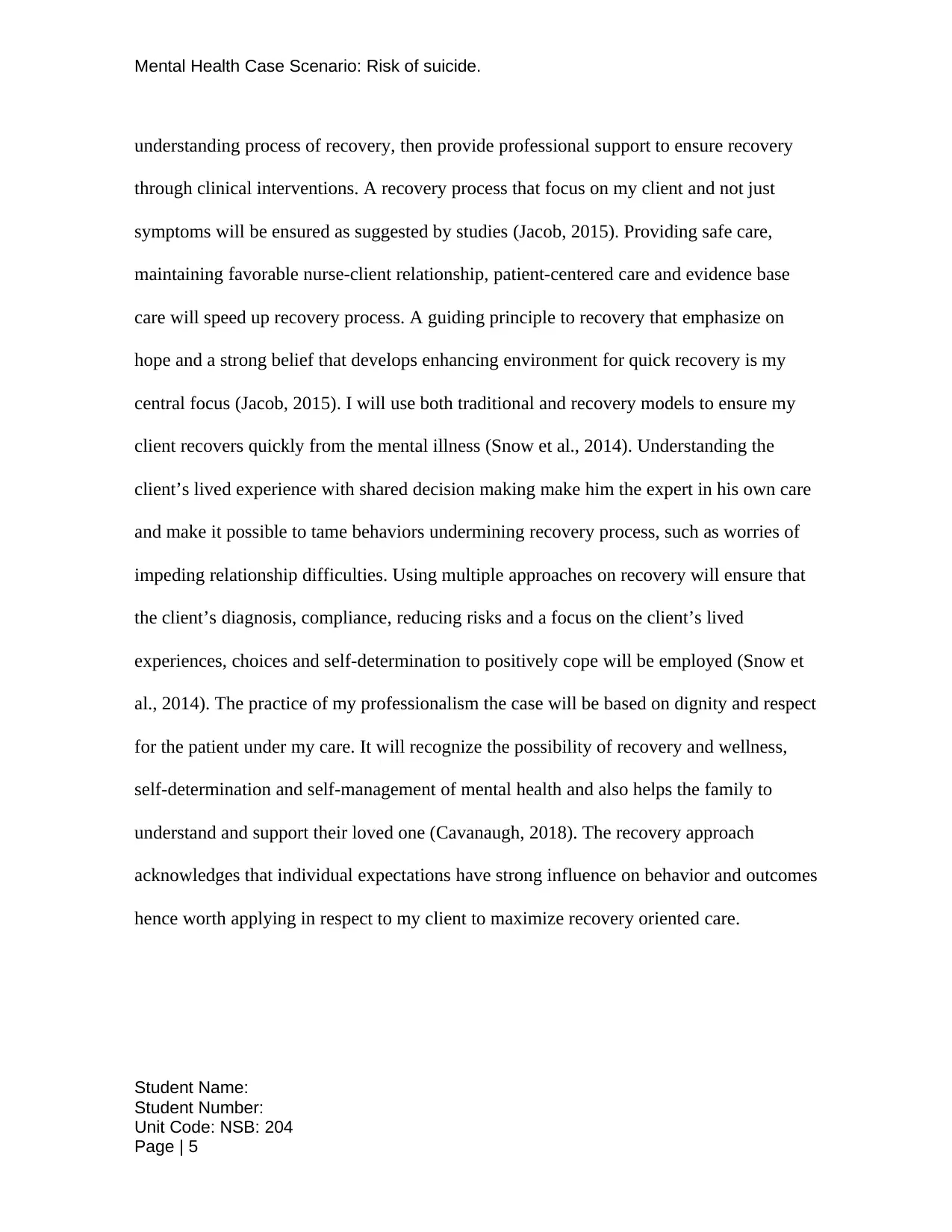
Mental Health Case Scenario: Risk of suicide.
understanding process of recovery, then provide professional support to ensure recovery
through clinical interventions. A recovery process that focus on my client and not just
symptoms will be ensured as suggested by studies (Jacob, 2015). Providing safe care,
maintaining favorable nurse-client relationship, patient-centered care and evidence base
care will speed up recovery process. A guiding principle to recovery that emphasize on
hope and a strong belief that develops enhancing environment for quick recovery is my
central focus (Jacob, 2015). I will use both traditional and recovery models to ensure my
client recovers quickly from the mental illness (Snow et al., 2014). Understanding the
client’s lived experience with shared decision making make him the expert in his own care
and make it possible to tame behaviors undermining recovery process, such as worries of
impeding relationship difficulties. Using multiple approaches on recovery will ensure that
the client’s diagnosis, compliance, reducing risks and a focus on the client’s lived
experiences, choices and self-determination to positively cope will be employed (Snow et
al., 2014). The practice of my professionalism the case will be based on dignity and respect
for the patient under my care. It will recognize the possibility of recovery and wellness,
self-determination and self-management of mental health and also helps the family to
understand and support their loved one (Cavanaugh, 2018). The recovery approach
acknowledges that individual expectations have strong influence on behavior and outcomes
hence worth applying in respect to my client to maximize recovery oriented care.
Student Name:
Student Number:
Unit Code: NSB: 204
Page | 5
understanding process of recovery, then provide professional support to ensure recovery
through clinical interventions. A recovery process that focus on my client and not just
symptoms will be ensured as suggested by studies (Jacob, 2015). Providing safe care,
maintaining favorable nurse-client relationship, patient-centered care and evidence base
care will speed up recovery process. A guiding principle to recovery that emphasize on
hope and a strong belief that develops enhancing environment for quick recovery is my
central focus (Jacob, 2015). I will use both traditional and recovery models to ensure my
client recovers quickly from the mental illness (Snow et al., 2014). Understanding the
client’s lived experience with shared decision making make him the expert in his own care
and make it possible to tame behaviors undermining recovery process, such as worries of
impeding relationship difficulties. Using multiple approaches on recovery will ensure that
the client’s diagnosis, compliance, reducing risks and a focus on the client’s lived
experiences, choices and self-determination to positively cope will be employed (Snow et
al., 2014). The practice of my professionalism the case will be based on dignity and respect
for the patient under my care. It will recognize the possibility of recovery and wellness,
self-determination and self-management of mental health and also helps the family to
understand and support their loved one (Cavanaugh, 2018). The recovery approach
acknowledges that individual expectations have strong influence on behavior and outcomes
hence worth applying in respect to my client to maximize recovery oriented care.
Student Name:
Student Number:
Unit Code: NSB: 204
Page | 5
Paraphrase This Document
Need a fresh take? Get an instant paraphrase of this document with our AI Paraphraser

Mental Health Case Scenario: Risk of suicide.
References
Australian Commission on Safety and Quality in Health Care. (2017).National Consensus
Statement: Essential elements for recognizing and responding to deterioration in a
person’s mental state. Sydney, ACSQHC.
Student Name:
Student Number:
Unit Code: NSB: 204
Page | 6
References
Australian Commission on Safety and Quality in Health Care. (2017).National Consensus
Statement: Essential elements for recognizing and responding to deterioration in a
person’s mental state. Sydney, ACSQHC.
Student Name:
Student Number:
Unit Code: NSB: 204
Page | 6

Mental Health Case Scenario: Risk of suicide.
Bolton, J.W. (2015).How to integrate biological, psychological, and sociological
knowledge in psychiatric education: A case formulation seminar series. Acad
Psychiatry, 39(1), 699-702.doi.https://doi.org/10.1007/s40596-014-0223-7
Cavanaugh, S. (2018). Recovery-Oriented Practice. Journal of Mental Health and
Addiction Nursing, 2(1), 28-30. doi: 10.22374/jmhan.v2i1.27
Choi, S. B., Lee, W., Yoon, J.-H., Won, J.-U., & Kim, D. W. (2017). Risk factors of
suicide attempt among people with suicidal ideation in South Korea: a cross-
sectional study. BMC Public Health, 17, 579. http://doi.org/10.1186/s12889-017-
4491-5
Crane, P.J., &Ward, S.F. (2016).Self-Healing and Self-Care for Nurses.AORN Journal,
104(5), 386-400.doi:doi:10.1016/j.aorn.2016.09.007
Epner, D.E., Baile, W.F. (2012).Patient-centered care: the key to cultural competence.
Annals of Oncology, 23(3), 3–42.doi:https://doi.org/10.1093/annonc/mds086
Fernando, I., Cohen, M. (2014).Case formulation and management using pattern-based
formulation (PBF) methodology: Clinical Case 1.Australas Psychiatry, 22(1), 32-
40.doi: https://doi.org/10.1177/1039856218789785
Hunter,L.(2016).Making time and space: the impact of mindfulness training on nursing
and midwifery practice. A critical interpretative synthesis. Journal of Clinical
Nursing, 25(7-8), 918-929. doi:doi:10.1111/jocn.13164
Student Name:
Student Number:
Unit Code: NSB: 204
Page | 7
Bolton, J.W. (2015).How to integrate biological, psychological, and sociological
knowledge in psychiatric education: A case formulation seminar series. Acad
Psychiatry, 39(1), 699-702.doi.https://doi.org/10.1007/s40596-014-0223-7
Cavanaugh, S. (2018). Recovery-Oriented Practice. Journal of Mental Health and
Addiction Nursing, 2(1), 28-30. doi: 10.22374/jmhan.v2i1.27
Choi, S. B., Lee, W., Yoon, J.-H., Won, J.-U., & Kim, D. W. (2017). Risk factors of
suicide attempt among people with suicidal ideation in South Korea: a cross-
sectional study. BMC Public Health, 17, 579. http://doi.org/10.1186/s12889-017-
4491-5
Crane, P.J., &Ward, S.F. (2016).Self-Healing and Self-Care for Nurses.AORN Journal,
104(5), 386-400.doi:doi:10.1016/j.aorn.2016.09.007
Epner, D.E., Baile, W.F. (2012).Patient-centered care: the key to cultural competence.
Annals of Oncology, 23(3), 3–42.doi:https://doi.org/10.1093/annonc/mds086
Fernando, I., Cohen, M. (2014).Case formulation and management using pattern-based
formulation (PBF) methodology: Clinical Case 1.Australas Psychiatry, 22(1), 32-
40.doi: https://doi.org/10.1177/1039856218789785
Hunter,L.(2016).Making time and space: the impact of mindfulness training on nursing
and midwifery practice. A critical interpretative synthesis. Journal of Clinical
Nursing, 25(7-8), 918-929. doi:doi:10.1111/jocn.13164
Student Name:
Student Number:
Unit Code: NSB: 204
Page | 7
⊘ This is a preview!⊘
Do you want full access?
Subscribe today to unlock all pages.

Trusted by 1+ million students worldwide
1 out of 16
Related Documents
Your All-in-One AI-Powered Toolkit for Academic Success.
+13062052269
info@desklib.com
Available 24*7 on WhatsApp / Email
![[object Object]](/_next/static/media/star-bottom.7253800d.svg)
Unlock your academic potential
Copyright © 2020–2025 A2Z Services. All Rights Reserved. Developed and managed by ZUCOL.





